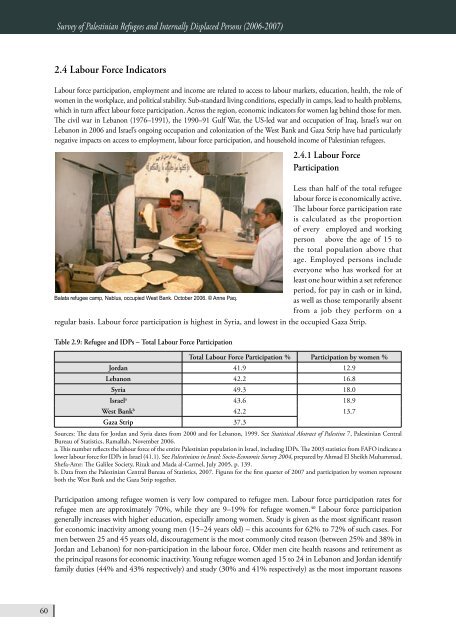BADIL Resource Center for Palestinian Residency and Refugee
BADIL Resource Center for Palestinian Residency and Refugee
BADIL Resource Center for Palestinian Residency and Refugee
Create successful ePaper yourself
Turn your PDF publications into a flip-book with our unique Google optimized e-Paper software.
60<br />
Survey of <strong>Palestinian</strong> <strong>Refugee</strong>s <strong>and</strong> Internally Displaced Persons (2006-2007)<br />
2.4 Labour Force Indicators<br />
Labour <strong>for</strong>ce participation, employment <strong>and</strong> income are related to access to labour markets, education, health, the role of<br />
women in the workplace, <strong>and</strong> political stability. Sub-st<strong>and</strong>ard living conditions, especially in camps, lead to health problems,<br />
which in turn affect labour <strong>for</strong>ce participation. Across the region, economic indicators <strong>for</strong> women lag behind those <strong>for</strong> men.<br />
The civil war in Lebanon (1976–1991), the 1990–91 Gulf War, the US-led war <strong>and</strong> occupation of Iraq, Israel’s war on<br />
Lebanon in 2006 <strong>and</strong> Israel’s ongoing occupation <strong>and</strong> colonization of the West Bank <strong>and</strong> Gaza Strip have had particularly<br />
negative impacts on access to employment, labour <strong>for</strong>ce participation, <strong>and</strong> household income of <strong>Palestinian</strong> refugees.<br />
Less than half of the total refugee<br />
labour <strong>for</strong>ce is economically active.<br />
The labour <strong>for</strong>ce participation rate<br />
is calculated as the proportion<br />
of every employed <strong>and</strong> working<br />
person above the age of 15 to<br />
the total population above that<br />
age. Employed persons include<br />
everyone who has worked <strong>for</strong> at<br />
least one hour within a set reference<br />
period, <strong>for</strong> pay in cash or in kind,<br />
Balata refugee camp, Nablus, occupied West Bank. October 2006. © Anne Paq.<br />
as well as those temporarily absent<br />
from a job they per<strong>for</strong>m on a<br />
regular basis. Labour <strong>for</strong>ce participation is highest in Syria, <strong>and</strong> lowest in the occupied Gaza Strip.<br />
Table 2.9: <strong>Refugee</strong> <strong>and</strong> IDPs – Total Labour Force Participation<br />
Total Labour Force Participation % Participation by women %<br />
Jordan 41.9 12.9<br />
Lebanon 42.2 16.8<br />
Syria 49.3 18.0<br />
Israel a 43.6 18.9<br />
West Bank b 42.2 13.7<br />
Gaza Strip 37.3<br />
2.4.1 Labour Force<br />
Participation<br />
Sources: The data <strong>for</strong> Jordan <strong>and</strong> Syria dates from 2000 <strong>and</strong> <strong>for</strong> Lebanon, 1999. See Statistical Abstract of Palestine 7, <strong>Palestinian</strong> Central<br />
Bureau of Statistics, Ramallah, November 2006.<br />
a. This number reflects the labour <strong>for</strong>ce of the entire <strong>Palestinian</strong> population in Israel, including IDPs. The 2003 statistics from FAFO indicate a<br />
lower labour <strong>for</strong>ce <strong>for</strong> IDPs in Israel (41.1). See <strong>Palestinian</strong>s in Israel: Socio-Economic Survey 2004, prepared by Ahmad El Sheikh Muhammad,<br />
Shefa-Amr: The Galilee Society, Rizak <strong>and</strong> Mada al-Carmel, July 2005, p. 139.<br />
b. Data from the <strong>Palestinian</strong> Central Bureau of Statistics, 2007. Figures <strong>for</strong> the first quarter of 2007 <strong>and</strong> participation by women represent<br />
both the West Bank <strong>and</strong> the Gaza Strip together.<br />
Participation among refugee women is very low compared to refugee men. Labour <strong>for</strong>ce participation rates <strong>for</strong><br />
refugee men are approximately 70%, while they are 9–19% <strong>for</strong> refugee women. 40 Labour <strong>for</strong>ce participation<br />
generally increases with higher education, especially among women. Study is given as the most significant reason<br />
<strong>for</strong> economic inactivity among young men (15–24 years old) – this accounts <strong>for</strong> 62% to 72% of such cases. For<br />
men between 25 <strong>and</strong> 45 years old, discouragement is the most commonly cited reason (between 25% <strong>and</strong> 38% in<br />
Jordan <strong>and</strong> Lebanon) <strong>for</strong> non-participation in the labour <strong>for</strong>ce. Older men cite health reasons <strong>and</strong> retirement as<br />
the principal reasons <strong>for</strong> economic inactivity. Young refugee women aged 15 to 24 in Lebanon <strong>and</strong> Jordan identify<br />
family duties (44% <strong>and</strong> 43% respectively) <strong>and</strong> study (30% <strong>and</strong> 41% respectively) as the most important reasons

















